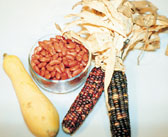
When you think of American food, do images of hamburgers, hot dogs, apple pie or even pizza pop into your mind? How about popcorn, peanuts, pumpkins or potatoes? Because of our countryís integrated cultures, any interpretation of American foods can be unique and plentiful. But there is a wealth of history to the foods that originated in the American continents. This recipe for vegetable enchiladas may not be traditional to any one particular American culture, but instead, it combines gathered and cultivated foods that are basic to the great civilizations of the "New World."
The enchilada wrapping is a corn tortilla, which can be made from scratch or bought in the grocery store. Corn is one of the most important plants grown by American Indians. It was the dietary staple of many early cultures, from the Incas of Peru to the Mississippi Mound Builders. A rare exception is in the mountainous regions, where corn could not grow and potatoes provided the main starch for the Incas.
Fluffy, unleavened corn tortillas may have been the first American bread. Scientists have dated corn to at least 3500 BC, when it is thought to have originated in southern Mexico or central America. Today, most American breads are made from wheat, which didnít grow here until Europeans brought it with them to the New World.
The stuffing in this recipe is a mixture of squash, beans and peppers. You can incorporate mixtures of salmon, seafood, venison, turkey or other indigenous meats or proteins and still keep the recipe true to an American culture. Squash, beans and corn are often referred to as the "Indian Triad" because they formed the staples of American Indian agriculture and diet. The Iroquois called the same three crops the "Three Sisters." In prehistoric caves in the Tamaulipas mountains of Mexico, archeologists have found 9,000-year-old squash seeds and stems. They believe the seeds, with their rich oils, were more valuable than the fruit.
The Aztec word for bean is "ayacotl." Gardeners who like to plant beans and corn can try planting the beans right next to the corn stalk. This traditional native technique was functional for several reasons. The stalk itself provides support for the bean vines to grow. The beans also attract bacteria that absorb the sugar from the cornís roots, and they enrich the soil by producing nitrogen, a nutrient that is depleted in soil where corn is grown. Planted together, corn and beans thus compliment each other. So, if you ever hear someone say, "they go together like beans and corn," youíll know itís a good thing!
This recipe calls for bell peppers and peppercorns -- chiles are optional. The two plants are not related. Peppers got their name either through oversight or good marketing on the part of the Spanish explorers that landed in America in search of India. Their quest was for gold and one of Indiaís rich spices, Piper Nigrum. They say the spice, black peppercorns, was worth its weight in gold. Imagine that -- one trip to the Strip District could buy a college education! The explorers were fond of the spiciness of chiles and took the fruits back to Europe, calling them "Pimento" or pepper. Within a decade, they were planting them all over Europe. Now we find them in dishes all over the world.
This enchilada recipe can be a great way to pass on the stories and legends of foods to younger members of the family. It is easy to get the whole family involved in making this dish. Try setting up a family assembly line. Once any dangerous activity such as frying is over, children enjoy stuffing and rolling the enchiladas. Thatís how I learned.
Lynn Parrucci is the Education Coordinator for the Carnegie Science Centerís Kitchen Theater.
Vegetable Enchiladas
Vegetable Mix:1 zucchini, diced1 yellow squash, diced1 red bell pepper, diced1 green or purple bell pepper, diced1 orange bell pepper, diced1 yellow bell pepper, diced 1 cup of sweet corn kernels, fresh or thawed
Additional ingredients:
2 cans of black refried beans (no lard)
1 lb. of Canadian or sharp white cheddar cheese
2 T. green peppercorns (packed in brine), rinsed
2 cans of enchilada sauce
cooking oil (olive, cannola or safflower)
20-30 corn tortilla shells
1. Prepare your vegetables and toss them together in a large mixing bowl. Add 1 cup of enchilada sauce and green peppercorns. Set aside.
2.Grate the cheddar cheese. Set aside.
3. Fill a frying pan with enough oil to cover the bottom one inch. Heat the oil so that shells cause a rapid boil. Fry each shell one at a time until it bubbles thoroughly. Drain well and blot with paper towels. Set aside.
4. Preheat the oven to 375¡F.
5. Spread a layer of enchilada sauce on the bottom of each baking dish.
6.Spread a thin coat of refried beans on each shell.
7. Spoon in filling and add just enough cheese so that you can still roll the enchilada.
8. When the pan is full, spread sauce over the top and sprinkle on more cheese.
9.Bake for 25-30 minutes. Remove and let cool. Do not serve immediately
-- the enchiladas will fall apart if they are too hot.
Contents |
Highlights |
Calendar |
Back Issues |
Museums |